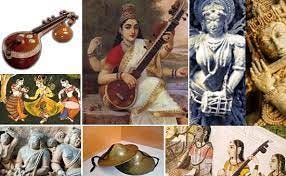Traditional Indian Music's Timeless Influence and Global Inspiration
Dive into the soulful realm of Traditional Indian Music, where timeless melodies resonate globally, bridging cultures and inspiring generations.
Welcome to another edition of Ancient Wonders, where we explore the richness of cultural treasures from around the world. In this edition, we delve into the mesmerizing world of Traditional Indian Music, a timeless art form that has not only endured through centuries but continues to inspire and captivate audiences globally.
The Essence of Traditional Indian Music: A Journey Through Time
India, with its diverse cultural tapestry, is a land where music is not just an art form but a profound spiritual and emotional experience. Rooted in ancient traditions, Indian classical music is a testament to the depth of human expression and the innate connection between rhythm, melody, and the human soul.
Raaga and Taala: The Pillars of Indian Classical Music
At the heart of traditional Indian music lies the concept of Raaga and Taala. Raaga, representing the melodic aspect, is a framework for creating emotional and aesthetic experiences.
It is a complex system with hundreds of ragas, each associated with specific times, seasons, and moods. On the other hand, Taala, the rhythmic cycle, provides the intricate patterns that form the rhythmic structure of the music.
These foundational elements offer a vast canvas for musicians to explore, ensuring that no two performances are ever the same. The improvisational nature of Indian classical music allows for a dynamic and spontaneous interplay between the artist and the audience.
Instruments: The Divine Symphony
Indian classical music features a plethora of traditional instruments, each with its unique sound and significance. The sitar, tabla, sarod, flute, and veena are just a few examples that contribute to the symphony of this rich musical heritage.
The Sitar: A Stringed Tapestry of Emotion
The sitar, with its resonant strings and distinctive sound, has become synonymous with Indian classical music. It is an instrument that demands both technical mastery and emotional depth from the musician.
From the soulful alaap to the energetic jor and the rhythmic gat, the sitar weaves a tapestry of emotions that can transport listeners to a different realm.
The Tabla: Heartbeat of Indian Rhythms
No discussion of Indian classical music is complete without recognizing the tabla. A percussion instrument consisting of two hand-played drums, the tabla is the heartbeat of traditional Indian rhythms.
The intricate patterns created by the tabla player add layers of complexity and excitement to the performance, creating a rhythmic dialogue that is both captivating and awe-inspiring.
Spiritual Connection: Music as a Path to the Divine
In the Indian cultural context, music is not just an artistic pursuit; it is a sacred offering. The ancient treatises on music, such as the Natya Shastra, describe the divine origins of music and its role in connecting the human spirit with the divine. Indian classical music is often considered a form of meditation, a way to transcend the material world and attain a higher state of consciousness.
The Bhakti and Sufi Traditions: Devotion in Melody
Many classical compositions in India are rooted in devotional themes, expressing profound love and devotion to the divine.
Whether it's the bhajans of North India or the kritis of South India, the spiritual connection is palpable. The Sufi traditions, with their qawwalis and mystical poetry, further exemplify the power of music to evoke a deep sense of devotion and unity.
Inspiration Beyond Borders: Impact on Global Music
In the modern era, the influence of traditional Indian music has transcended geographical boundaries. From the iconic collaborations of Ravi Shankar with George Harrison of The Beatles to the fusion experiments of artists like Anoushka Shankar and Zakir Hussain, Indian classical music has found resonance with audiences worldwide.
The Rise of Fusion: Blending Tradition with Modernity
The fusion of traditional Indian music with various genres, including jazz, rock, and electronic music, has given rise to a new wave of artistic expression.
This cross-cultural pollination not only preserves the essence of Indian classical music but also introduces it to a broader, contemporary audience.
Preserving the Heritage: The Role of Contemporary Artists
In the digital age, where trends come and go at the speed of light, it is crucial to recognize the efforts of contemporary artists in preserving and promoting traditional Indian music.
Platforms like Substack provide a unique space for enthusiasts and artists to share their insights, experiences, and knowledge, fostering a global community that appreciates the beauty and complexity of this ancient art form.
Educational Initiatives: Nurturing the Next Generation
Educational initiatives play a vital role in ensuring the continuity of Indian classical music. Schools, workshops, and online courses contribute to the transmission of knowledge from seasoned maestros to aspiring musicians.
By embracing technology, these initiatives make the learning process more accessible to a wider audience, ensuring that the flame of tradition continues to burn brightly.
Conclusion: A Timeless Tapestry of Sound
As we explore the depths of Traditional Indian Music, we discover a world where every note, every rhythm, and every nuance carries the weight of centuries. It is a world where tradition and innovation coalesce, where the spiritual and the artistic converge.
Indian classical music is not merely an auditory experience; it is a journey through time, a source of inspiration that transcends cultural boundaries and resonates with the universal language of the human soul. May the melodies of this ancient wonder continue to echo through the ages, inspiring generations to come.
👍 Enjoyed the read? Give us a thumbs up and spread the magic of Indian classical music! Hit the like button to show your love and appreciation for the harmonious wonders we unravel.





I liked your article but I would have liked it more if you had given some ideas where to start listening?!!